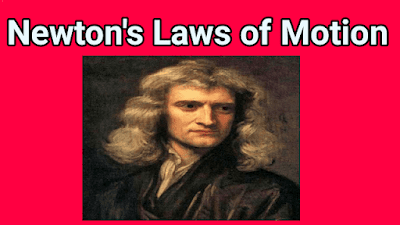Sir Isaac Newton is the most influential scientist of all time. Its reason is that he has done lots of work in the fields of Physics, Mathematics, and Astronomy. He dominated his scientific point of view by presenting Newton’s laws of motion (Newton’s First law of motion, Newton’s Second law of motion, and Newton’s Third law of motion). With the help of laws of motion, Newton presented three basic ideas. These basic ideas are applicable in mechanics. Scientists have tested these ideas. They have proved these ideas. These ideas are Newton’s three laws of motion.
Newton’s First Laws of Motion
Another name for Newton’s first law of motion is the Law of Inertia. Here, we have stated Newton’s first law of motion.
“If an object is at rest or moving with uniform speed, it will remain at rest or continue its uniform motion unless an unbalanced force is acting upon it.”
Examples of Newton’s First Law of Motion
There are various examples of Newton’s first law of motion. Here, we will explain the most important examples of Newton’s first law of motion. Physics lovers may also like to read about the difference between mass and weight.
♦ A book on the table. A book on the table is a practical example of Newton’s first law of motion. It means that a book will remain at rest on the table unless an unbalanced force is not acted upon it.
♦ Car moving with uniform speed. If a car is moving with uniform velocity, it will continue its uniform motion in the absence of frictional forces and force applied by the brakes. When we want to stop it, we have to consider frictional forces before applying brakes.
♦ If you kick a ball in space, it will move in space forever (if we ignore the force of gravity and air resistance). It will stop or change its direction only when it hits a meteoroid in space.
Why Should We Wear Seatbelts While Driving Cars?
The use of seatbelts while driving cars is the most important application of Newton’s first law of motion. Its reason is that when we are driving the car, everything in the car is moving at the same speed. If the car collides with another car or a brick wall, the car will stop instantly. Anyhow, the things in the cars will move at the same speed. If we have not worn a seatbelt, we will injure ourselves by hitting something in the car. On the other hand, if we have worn the seat belt, the seatbelt will also stop our bodies along with the car. As a result, we can save ourselves from the injury.
Newton’s Second Law of Motion
Newton’s second law of motion is also very useful in our practical life. Its reason is that with the help of Newton’s second law of motion, we can get the famous force-mass equation. Here, we will state Newton’s second law of motion.
“The acceleration produced in an object is directly proportional to the force applied on that object and inversely proportional to the mass of that object.”
Mathematically, we can present Newton’s second law of motion in the following way;
♦ a ∝ F …………………1
♦ a ∝ 1/m…………..…..2
By comparing equations 1 and 2, we get another equation.
♦ a ∝ F/m
♦ a = F/m
♦ F = ma
Daily Life Examples of Newton’s Second Law of Motion
There are various examples of Newton’s second law of motion. Here, we will discuss the most important examples of Newton’s second law of motion.
♦ If you are pushing a truck and a car by applying the same force, the car will move faster than the truck. Its reason is that the acceleration of the car is greater than the acceleration of the truck.
♦ If we are applying the same force to an empty shopping cart and a loaded shopping cart, the empty shopping cart will move faster than a loaded shopping cart. Its reason is that the mass of the empty shopping cart is less than the mass of a loaded shopping cart.
♦ If we hit the same force on a light ball and a heavy ball, the light ball will cover more distance than the heavy ball.
Newton’s Third Law of Motion
Newton’s third law of motion is the most famous. We can state it in the following way:
“Action and reaction are equal in magnitude but opposite in direction.”
Daily Life Examples of Newton’s Third Law of Motion
There are various examples of Newton’s third law of motion. Here, we will discuss the most important examples of Newton’s third law of motion.
♦ When we throw a ball toward the wall, the wall bounces back toward us. The force that we apply on the ball is the action and the force that walls exert on the ball is the reaction. We can observe that these two forces are equal in magnitude but opposite in direction.
♦ When air rushes out of a balloon, it is the action. As a result of this action, the balloon moves back, it is the reaction.
♦ If you want to dive off a diving board, you will have to push down the diving springboard. The board springs back and it forces you into the air.
Importance of Newton’s Laws of Motion
In Physics, we have to deal with these laws in various aspects. Therefore, we can’t deny the importance of these laws. Here, we will discuss the importance of these laws.
♦ With the help of Newton’s laws of motion, we can form the most intuitive and appealing physical theory.
♦ With the help of these laws, it is also possible for us to describe the diverse aspects of nature. We can describe these aspects by using basic mathematical formulas.
♦ These laws are also actually working in daily life.
♦ With the help of these laws, we can lay the groundwork for later physics developments.
Frequently Asked Questions – FAQs
1. What will happen if you let an untied balloon go?
When you will let an untied balloon go, air will rush out from the balloon. As a result, the balloon will move in the air. These two forces have equal magnitudes but they occur in opposite directions.
2. What will happen if you push Mr Wright?
Here, we consider that you have less mass than Mr Wright. When you will push Mr. Wright, you will not accelerate him. Its reason is that you can’t exert enough force to accelerate him. On the other hand, if Mr. Wright pushes you, you will move in the direction of the force. Mr. Wright can accelerate you because you have less mass than Mr. Wright.
3. Why do you have to hold your gun next to your shoulder while hunting?
When you pull the trigger of the gun, the bullet will force you out of the gun. On the other hand, the gun will be forced back towards you. It means that it will be forced back in the opposite direction of the bullet. That’s why you have to keep a gun on your shoulder to keep it flying away from you.
4. Why do we call Newton’s first law of motion the law of inertia?
According to the law of inertia, an object resists its state of motion until we apply an unbalanced force on it. This statement is similar to the statement of Newton’s first law of motion. That’s why we call Newton’s first law of motion the law of inertia.
5. Why do heavier objects require more force than lighter objects for accelerating?
According to Newton’s second law of motion F=ma. It means that the product of mass and acceleration is equal to the force. According to this equation, if we want to accelerate a heavier object, we will have to apply more force. On the other hand, if we want to accelerate a lighter object, we have to apply less force.
6. How to launch rockets into space?
To launch rockets into space, we have to apply Newton’s third law of motion. When we launch a rocket into space, it pushes out the fire. It pushes out the fire with a specific force. As a result of this force, the rocket moves forward in the air. Anyhow, the force of the fire and the movement of the rocket have the same magnitudes but they act in opposite directions.
7. What is the role of Newton’s laws in our daily life?
Everything that is happening in this world has a connection with Newton’s laws of motion. Its reason is that there is the involvement of the force in all things. That’s why we can say that these laws are playing a vital role in our daily life.







2 thoughts on “Newton’s Laws of Motion – First, Second, Third”